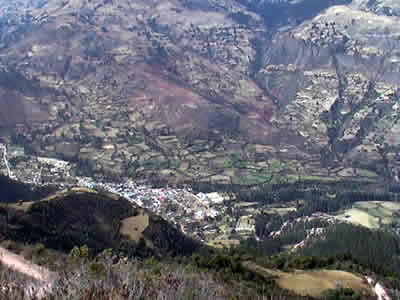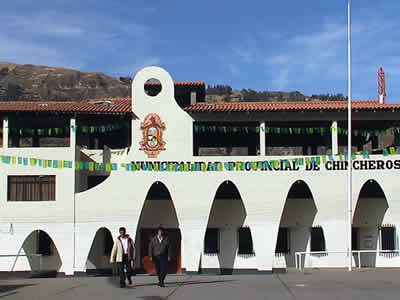CHINCHEROS
Chincheros one of the 07 provinces of the department of Apurímac. Its history goes back to the first groupings that would have populated the territory does 5 thousand years; finding a zone with an agricultural potential. The development of these towns seated in the region was based on agriculture, because the sedentary life increased the production and to assure its feeding impulse the agricultural technology, as well as the increase of the production in the domesticación of plants.
The history of Chincheros goes related to Andahuaylas, by a mythical history; the one is said that the settlers have left the lagoon of Chocqlloqocha, in Huancavelica, located on the 4000 msnm, that would be its paqarina or source of origin and life; of this a migration takes place towards Andahuaylas in search of better earth to be developed, following the direction of the Pampas river.

VISTA PANORAMICA DE CHINCHEROS
Towards centuries XIII and XV, when the regional states of this zone completely were formed and constituted, a contradiction between Chancas arises and the Incas of the Cusco, facing in prolonged battles. The Chancas initially was located between the Pampas river and the Pachachaca river. When expanding, they made of the area of Andahuaylas its main seat, this confederation was conformed by the Hancohuallus, the Utumsullas and the Urumarcas. The initiator of the expansion of chancas I am called Uscovilca, ancestor of Anco Huayllu. This group was in charge to develop an independent culture and had its own language, the puquina; and they domesticated to the flame. Investigations made by J. González Carré and Lorenzo Orchards document that the influence of this nation was radiated from Apurímac to Ayacucho and Huancavelica, in this way they put under the Wankavilcas and Rukanas. After putting under the Soras, the Chancas penetrated in the territories of the Quechuas Antahuayllas, through the Chicha river, that strongly resisted the invasion of the Chancas, being won emigrated towards Aymaraes. Consolidated the conquest in all the region they transferred the military political power of Vilcashuamán to Antahuaylla, place of the capital of the Tribal Confederation Chanca. This annexation happened in the reign of Able Mayta the year of 1300.
Being the caudillo chanca Ancco Huayllu I conform an army respectable of 40 thousand men to the control of the brothers: Asto Waraka and Tumay Waraka; in the reign of yawar waqaq, having knowledge of which the Incas went through political difficulties with the Wayllakanes, they hurried the war invading the Cusco, from the valley of Antahuaylla, place of enough supplying, went to the Cusco by the Vilkakunka route, being a front door to Ichupampa, arriving to fight in the Strength of Sacsaywuaman, where they found resistance, they were forced to back down to its bases of Antahuaylla and intercepted in the way by the Pachacutec Inca, occurring the famous battle of Yawarpampa (blood field).
According to the story of the cronistas in the battle, chancas and 08 thousand cuzqueños died 22 thousands. Captains Asto Waraka and Tumay Waraka succumbed heroically and Ancco Huayllu was hurt and catched. According to the cronista Bernabé Cobo, it mentions one second offensive of chancas, headed by Ancco Huayllu that nonsingle had managed to escape but to reunite to 08 thousand combatants in Challcumarca and Suramarca, this time to recover the lost territories. Seeing itself in inferiority of forces, it chose to save towards the forest being followed the course of the Urubamba river. Its internamiento I am made in the territories of the Huallaga and of to the jurisdiction of You lick there of the department of San Martín where to the date they keep its ethnic identity without mestizar itself.
In the Incaico period the zone took the name of "Ajay Pampas", because the zone elaborated licores, derivatives of the maize, to which "chicha" was denominated to him. With the arrival of the conquerors it was changed to Chincheros in honor chicha. During the colony, Chincheros was part of the party of Andahuaylas that belonged to Intendance of Huamanga. The Republic, the parties transform into provinces and Intendance in departments. In 1846, with the Supreme Decree Nº 024765/46 the district of Chincheros is created, with the denomination of VILLA CHINCHEROS. The 28 of April of 1873 the department of Apurímac is created, arranging that the provinces department Ayacucho to Cusco comprise of Andahuaylas, Abancay, Aymaraes, Antabamba and Cotabambas, first of them pertaining to the other and. Still this double origin is visible, because geographic Andahuaylas and culturally this tie ones to Ayacucho, just as the province of Chincheros, whereas Abancay this tie ones to Cusco.

CHINCHEROS
Its appointment as independent province of Andahuaylas occurred 30 of December of 1983; with the Decree Law Nº 23759, "It created in the department of Apurímac, the province of Chincheros, whose capital will be the villa of Chincheros. The province of Chincheros will be constituted by the district of Chincheros with its capital the villa of Chincheros, Ongoy with its capital the villa of Ongoy, Ocobamba with its capital the villa of Ocobamba, Cocharcas with its capital of the Cocharcas town and Anccohuayllo with its capital the town of Uripa, determines the limits of the province of Chincheros dismantling itself of the territory of the province of Andahuaylas ". Its creation silk in the government of the Arq. Fernando Belaunde Terry.
Old the Chancas has left track of their past, which they are possible to be stated in his constructions and that to the date much battle area for the investigators whom they love to study legendary last saying, in those days are that did not exist the town of chincheros, but its ground net agriculturist and her people net agriculturist stuck to its earth so that there it subsisted helped by his apt pleasant climate to develop the agricultural activities.
LOCATION POLITICA And GEOGRAFICA
Policy: The district of Chincheros is the capital of the Province of Chincheros, department of Apurímac; to the Nor the West of the province of Abancay, between the 1000 up to 4438 msnm.
The province of Chincheros this located to the extreme west of the department of Apurímac. Its capital homónima is located to 2800 msnm, on the margin of the Chincheros river, that is one of the affluents of the Pampas river. This divided politically in 08 districts, as one is in the following picture.
Geographic: The district of Chincheros is located in the Nor part This of the Department of Apurímac, South Latitude 12º30´50 "and West longitude 73º43´13".
Extension and Altitude
The district of Chincheros, has an extension of 132,40 Km2, provincial level represents 10,6 % of 1246,77 Km2, being at departmental level 0,6 % of 20895,79 Km2. The topography is enough rustic victim and presenting/displaying deep gorges in the configuration of its territory.
Distrital geography is located in different altitudinales floors with diverse morphologic, climatic and biogeográficos characters: Yunga (between the 1000 to 2500 msnm), Quechua (between 2500 and 3500 msnm), Suni (between 3500 and 4100 msnm) and Puna (on 4100 and 4438 msnm).

CHINCHEROS MUNICIPALITY
LIMIT And ACCESSES
The District of Chincheros has the following limits:
North: District of Ongoy and Uripa of the province of Chincheros.
The south: Province of Vilcahuamán and Huamanga of the department of Ayacucho.
This: District of Uripa of the province of Chincheros.
The west: District of Huaccana and the province of Huamanga.
The access to the District of Chincheros from the city of Abancay to Andahuaylas is by a hard road in 240 km, with a duration of 06 hours of trip. From Andahuaylas it is made by a hard road of 90 km, with a duration of 03 hours of trip.
Dividing of the capital city Lima until Ayacucho a route by a hard road becomes of 480 km, with a duration of 08 hours of trip. Of this point until Chincheros a trip of 06 hours with 100 km of route becomes; by an affirmed route.
The access to the district of Chincheros is made in deprived vehicles, also of massive transport of passengers, the entrance of transport of small load, medium and heavy it is made by the production at departmental level and to be in the main route between markets of the coast and mountain range.
At internal level 77 km exist, of highway of connection with their populated centers; also the use of pack animal roads on the part of the population at distrital level.
Página web creada el 30 de marzo del 2005.
© Copyright 2005 Gualberto Valderrama C.
|